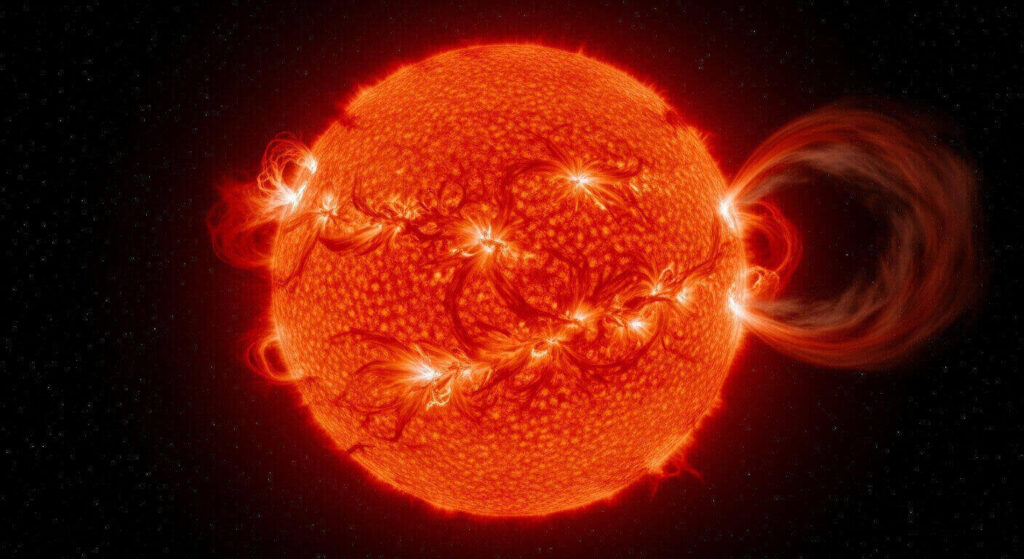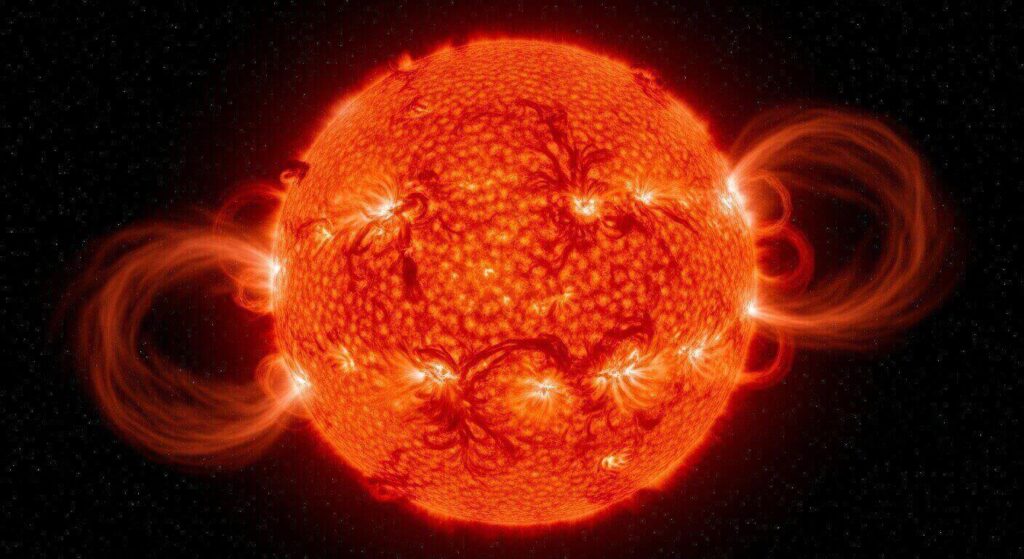Will Betelgeuse Explode? The Full Story of the Red Giant’s Great Dimming and Uncertain Future. This post dives deep into the science behind Betelgeuse’s mysterious 2019 dimming, exploring its massive size, turbulent surface, and what it all means for its eventual supernova.

Ever since I was a kid, I’ve been captivated by the cosmos. I’d spend hours in my backyard with a telescope, and one of the first constellations I learned to identify was Orion. You just can’t miss it. And on its shoulder, that fiery, reddish star always stood out: Betelgeuse. We’re taught that stars are just distant points of light, their true faces hidden by immense distance. For every star but one—our Sun—that’s true. Or is it? Amazingly, there’s another star whose surface we can actually see, a giant preparing for its final act nearly 700 light-years away. That star is Betelgeuse. A couple of years ago, it gave us all a huge surprise by suddenly dimming, a change so dramatic you could see it with the naked eye. Was it about to go supernova? Well, it’s still here, but thanks to incredible technology and dedicated astronomers, we now have a much clearer picture of what really happened. Let’s explore the amazing story of how we’ve managed to photograph this distant giant’s surface. 😊
Table of Contents
- The Red Supergiant in Orion’s Shoulder
- Painting a Portrait from 700 Light-Years Away
- The Great Dimming of 2019: A Supernova Rehearsal?
- The Verdict: A Star That Sneezed
- Why Betelgeuse is Our Window into the Future
The Red Supergiant in Orion’s Shoulder 🤔
Betelgeuse isn’t just any star; it’s a red supergiant, a true behemoth of the cosmos. Located in the left shoulder of the constellation Orion, its name is derived from an Arabic phrase meaning “the armpit of Orion.” This star is in the final stages of its life and is destined to end in a spectacular supernova explosion. Just how big is it? Its radius is estimated to be around 887 times that of our Sun. If you were to place Betelgeuse at the center of our solar system, its surface would extend out to the orbit of Jupiter. It’s this colossal size, combined with its relative proximity—about 640-724 light-years away—that makes it one of the very few stars we can image as more than a mere point.
💡 Did You Know?
Despite its immense size, Betelgeuse is only about 8 million years old, a toddler compared to our 4.6-billion-year-old Sun. Massive stars like Betelgeuse burn through their fuel much faster, leading to shorter but more dramatic lives.
Painting a Portrait from 700 Light-Years Away 🔭
Resolving the surface of a star hundreds of light-years away is an incredible technical challenge. The effort began in earnest in the 1990s. In 1995, astronomers used the Hubble Space Telescope to capture the first direct image of a star other than our Sun—Betelgeuse. By observing it in ultraviolet light, they could see its chromosphere, revealing a massive, mysterious hot spot on its surface. This wasn’t a uniform sphere; it was a dynamic, boiling world.
More recently, advanced telescopes like the European Southern Observatory’s Very Large Telescope (VLT) and the Atacama Large Millimeter/submillimeter Array (ALMA) have given us even sharper views. ALMA, in particular, provided the highest-resolution image to date, showing that parts of the star’s surface are thousands of degrees hotter than others. These bright spots are the footprints of gigantic convection cells, bubbles of hot gas rising from the star’s interior. While the granules on our Sun are about the size of Texas, a single convection cell on Betelgeuse could swallow our entire solar system out to the orbit of Mars.
Betelgeuse vs. The Sun: A Tale of Two Stars
| Feature | Betelgeuse | The Sun |
|---|---|---|
| Type | Red Supergiant | Yellow Dwarf |
| Radius | ~887 Solar radii | 1 Solar radius |
| Age | ~8-10 Million Years | ~4.6 Billion Years |
| Eventual Fate | Type II Supernova | White Dwarf |
The Great Dimming of 2019: A Supernova Rehearsal? 📉
For centuries, astronomers knew Betelgeuse had a rhythm, a pulse that caused its brightness to vary on a cycle of about 400 days. But in late 2019, something different happened. The star began to fade dramatically, far more than its usual cycle. By February 2020, it had lost nearly two-thirds of its normal brilliance. As an avid observer, I could see the difference myself just by looking up at Orion—the mighty hunter looked like he had a weak shoulder! The astronomical community was buzzing. Could this be it? Was the star’s core finally collapsing, the prelude to the supernova we’ve all been waiting for?
📝 The View from the VLT
Images from the VLT were stunning. A January 2019 photo showed a bright, though asymmetrical, star. By December 2019, the southern hemisphere of the star was noticeably and shockingly dark, as if a great shadow had fallen over it.
The Verdict: A Star That Sneezed 💨
Alas, for those of us hoping for a cosmic fireworks show, it wasn’t meant to be. Not yet, anyway. After extensive observation from Hubble and other observatories, a consensus emerged. The Great Dimming wasn’t caused by an impending explosion, but by a massive cloud of dust.
Scientists concluded that Betelgeuse had undergone a Surface Mass Ejection (SME). Think of it like a colossal solar flare, but on a scale our Sun can’t even imagine. A huge chunk of the star’s surface—its photosphere—was blasted out into space. This ejected blob of hot gas, several times the mass of our Moon, traveled outwards and cooled, condensing into a vast cloud of dust. For a few months, this self-made dust cloud blocked the light from the star’s southern region from our point of view, causing the dramatic dimming. Betelgeuse essentially sneezed, and then we saw the cosmic handkerchief block its face.
⚠️ A Star Still Recovering!
Even though the dust has cleared and Betelgeuse has returned to its normal brightness, it’s not quite the same. The traumatic outburst disrupted its 400-day pulsation cycle. According to Andrea Dupree of the Harvard & Smithsonian Center for Astrophysics, the star’s interior is still “bouncing like a plate of gelatin dessert” as the photosphere rebuilds itself.
Why Betelgeuse is Our Window into the Future ✨
So, the big show was postponed. But this event was arguably more valuable to science. Supernovae happen without warning. We only get to study them *after* they’ve exploded. Betelgeuse offers us the unprecedented opportunity to watch a star in its death throes, to study the violent, chaotic processes that occur *before* the final blast. It’s our only ringside seat to the end of a massive star’s life.
Every burp, every dimming, every convulsion teaches us more about the physics of dying stars. It helps us refine our models of stellar evolution and understand how the heavy elements, forged in the hearts of stars like Betelgeuse, are eventually seeded throughout the universe. We are, after all, made of stardust, and Betelgeuse is showing us how that dust gets made.
💡
Betelgeuse: The Key Takeaways
✨ Not If, But When: Betelgeuse is guaranteed to go supernova, but likely not for another 100,000 years. The timeline is still debated, but it’s not happening tomorrow.
📉 The Great Dimming Explained: The 2019 dimming event was caused by a massive ejection of its own surface material, which cooled into a dust cloud that temporarily obscured the star.
🔭 A Unique Subject: Its immense size and proximity allow us to directly image its surface, offering an unparalleled look at the final, turbulent stages of a massive star’s life.
This star is our only preview of a supernova in the making.
Frequently Asked Questions ❓
Q: When will Betelgeuse actually explode?
A: While we know it’s in the final phase of its life, “soon” in astronomical terms is a very long time. The current scientific consensus places the likely supernova event anytime within the next 100,000 years. So, while it’s not impossible it could happen in our lifetime, it’s statistically very unlikely.
Q: What will the Betelgeuse supernova look like from Earth?
A: It will be a spectacular, once-in-a-civilization event! Astronomers predict it will shine as brightly as the half-moon, concentrated in a single point of light. It would be visible during the daytime for months and cast shadows at night. It would be an unmistakable beacon in the sky for everyone on Earth.
Q: Is the supernova dangerous to us on Earth?
A: No, thankfully we are at a very safe distance. A supernova would need to be within about 160 light-years to pose a threat to Earth’s biosphere with its radiation. Betelgeuse is about four times farther away than that, so we’ll get to enjoy the light show without any danger.
Q: Will we have any warning before it happens?
A: Yes! The explosion itself releases a massive burst of particles called neutrinos and gravitational waves before the light does. Our detectors on Earth would pick these up hours, or even a full day, before the supernova becomes visible, giving astronomers a heads-up to point every telescope they have at it.
Watching Betelgeuse is like watching history unfold in slow motion. We may not get the supernova in our lifetimes, but every new observation brings us closer to understanding the spectacular end that awaits this cosmic giant. What are your thoughts on Betelgeuse? Let me know in the comments below! 👇
